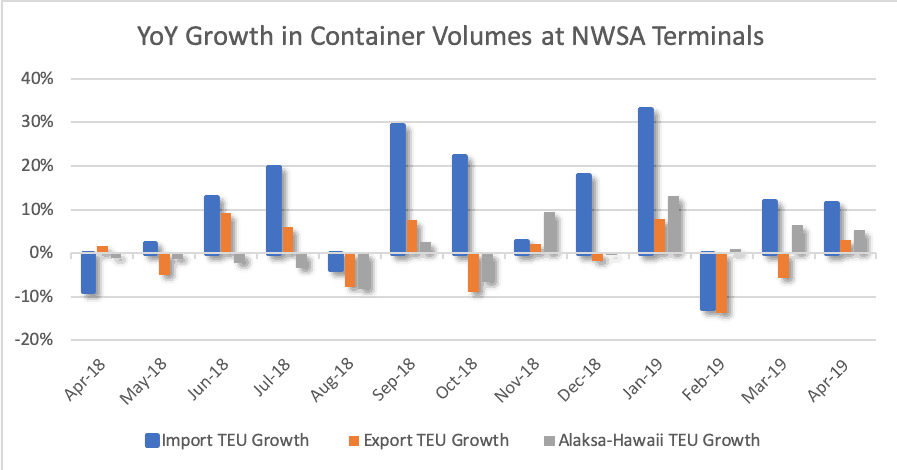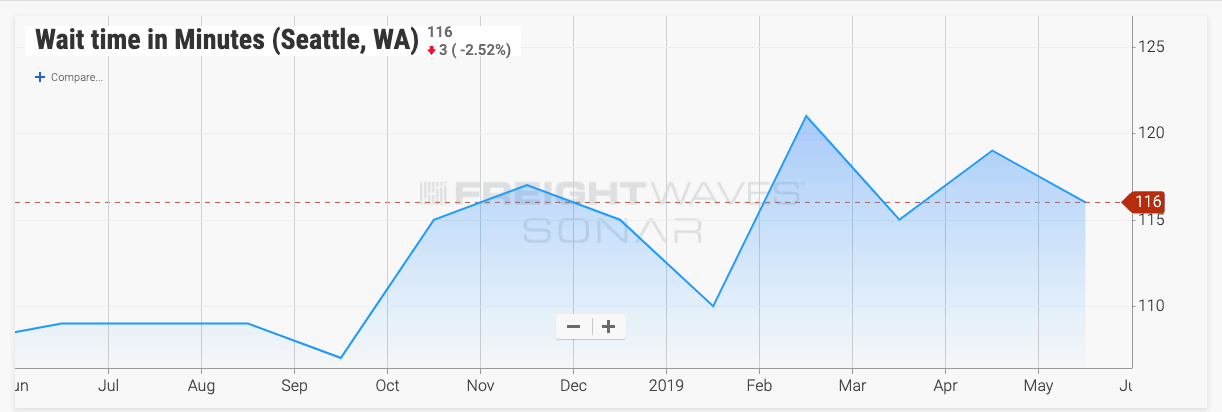Washington’s container ports are looking to incent marine terminals to open at off-peak hours for trucks in preparation for the peak shipping season.
The move underscores how U.S. ports are hoping to prevent a repeat of last year’s well-documented container congestion.
The Northwest Seaport Alliance (NWSA), which oversees the ports of Seattle and Tacoma, said it will provide $2 million to its members to fund the incentive program, which begins this July and runs through the end of 2020.
The program will pay for the costs of marine terminals offering extended gate hours for trucks picking up or dropping off containers, based on the number of off-peak hours offered weekly.
SSA Marine, which operates the two of the seven NWSA marine terminals, will be the first to participate in the new program. Starting July 1, it plans to offer trucking firms a window of 6:00 p.m. to 2:30 a.m. to drop-off of loaded exports or pick-up and deliver empty containers at Terminal 18, Seattle’s largest.
“It’s good to see SSA take the lead on this as they have a lot of volume,” said NWSA spokesperson Katie Whittier.
SSA is expected to draw about $600,000 of the incentive funds for the first month of extended gate operations, but self-fund it after that, Whittier said. Starting August 5, SSA T18 will charge a fee of $38 per loaded export container.
NWSA said the program’s aim is “to avoid backups and bottlenecks both on- and off-terminal by distributing drayage traffic throughout the day.”
As did its peers to the south and to the east, the Pacific Northwest saw a crush of containers cross its docks during the 2018 front-loading season. Monthly import volumes showed year-on-year growth of 20 percent or more during much of the latter half of 2018, before finally topping out at 30 percent in January.

Andy Garcia, Executive Vice President of Oakland, California-based GSC Logistics, said he welcomes any move to get marine terminal operators to provide off-peak gate hours.
During peak season, “it just becomes unmanageable to handle containers through Seattle-Tacoma ports with just a day shift,” Garcia said. “There is too much product that has to be moved in an eight hour cycle.”
He said GSC, which runs about 100 power units through the Pacific Northwest terminals, was encountering wait times between two and three hours at some terminals.
Detention did see a spike during that time with the Wait Time for the Seattle market (SONAR: WAIT.SEA) reaching its highest levels in the fourth quarter of 2018 before peaking at 120 minutes in February. Even now, Seattle wait times remain elevated.

Those delays resulted in detention charges ranging between $75 and $175 per container during the peak season, Garcia said.
He said appointment systems at two of the Seattle terminals have also gone a long way to reducing driver wait times in the Pacific Northwest. Some terminals have also periodically offered Saturday and early-morning gate hours to ease container flow.
“It increases the likelihood of customers choosing to disembark their freight on the West Coast,” Garcia said. “Anything that enhances how predictable and efficient it is to unload freight is an operational improvement.”
In addition to lower costs for the shipper, Garcia said efforts to increase turnaround times at the terminal also benefits drivers. As in other port markets, the independent contractors that haul freight for drayage need at least two or three turns per day to earn a living.
He added that the off-peak hour program “offers a greater guarantee of a driver getting two or three turns. It also enhances the likelihood of drivers staying in port drayage instead of looking for opportunities in over-the-road or long-haul freight.”
Don’t fret a dual transaction in Laos, CMA CGM says
Ceva Logistics will operate container depot for box moves through Thailand ports. (The Loadstar)
China’s Silk Road goes north for next venture
Cosco Shipping in tie-up with Russian firms to open Northern Sea Route. (VesselFinder)
Hapag-Lloyd finance chief to step down
Nicolas Burr’s contract expires next year, with Chile expected as next destination. (ShippingWatch)
Kuehne + Nagel takes look at shipping’s carbon output
World’s largest ocean freight procurer plans to rank carbon dioxide output of liners. (TradeWinds)











One Comment
Comments are closed.